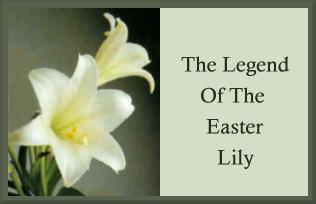
THE EASTER LILY
Often called the "white-robed apostles of hope," lilies were found
growing in the garden of Gethsemane after Christ's agony. Tradition has
it that the beautiful white lilies spring up where drops of Christ's
sweat fell to the ground in his final hours of sorrow and distress.
Christian churches continue this tradition at Easter by banking their
altars and surrounding their crosses with masses of Easter lilies to
commemorate the Resurrection and hope of life everlasting.
The pure white lily has also been closely associated with the Virgin
Mary. In early paintings, the Angel Gabriel is pictured extending to
Mary a branch of pure white lilies, announcing that she is to be the
Mother of the Christ child. In other paintings, saints are pictured
bringing vases full of white lilies to Mary and the Infant Jesus.
The legend is told that when Mary's tomb was visited three days after
her burial, it was found empty save for bunches of majestic white
lilies. Early writers and artists made the lily the emblem of the
Annunciation, the Resurrection of the Virgin: the pure white petals
signifying her spotless body and the golden anthers her soul glowing
with heavenly light.
On Easter Day the lilies bloom,
Triumphant, risen from their
tomb;
Their bulbs have undergone rebirth,
Born from the silence of
the earth
Symbolically, to tell all men
That Christ, the Savior,
lives again.
The angels, pure and white as they,
Have come and
rolled the stone away
And with the lifting of the stone,
The
shadow of the cross is gone!
~ June Masters Bacher
~
Love is such a mighty urge
At springtime of the
year,
Flowing pond and bursting buds
To tell us Easter's
near.
Life's as new, by act of faith,
As when the world
began,
Robins sing in every branch
And lilies rise again.
~
June Masters Bacher ~

|